Archived Storm Damage Blog Posts
Cracking the Code: The Science Behind Lightning – Debunking Myths and Unveiling Reality
1/3/2024 (Permalink)
Lightning, a dazzling display of nature's power, has long captivated human fascination. However, myths and misconceptions about this natural phenomenon have persisted throughout history. In this blog, we'll delve into the science behind lightning, dispelling common myths and uncovering the reality of this electrifying spectacle.
Myth: Lightning Never Strikes the Same Place Twice
Reality: Lightning Can Strike Repeatedly. Contrary to the popular saying, lightning can and does strike the same place more than once. In fact, tall structures such as skyscrapers, communication towers, and even certain trees are often struck repeatedly during thunderstorms due to their height and conductivity.
Myth: Lightning Only Occurs during Rainstorms
Reality: Lightning Can Happen in Clear Skies. While thunderstorms are a common breeding ground for lightning, it's not exclusive to rainy weather. Dry thunderstorms, characterized by lightning and thunder without precipitation reaching the ground, can occur in arid regions. Lightning can also happen within the eyewall of a hurricane, even when the surrounding area experiences clear weather.
Myth: Rubber Tires Protect You from Lightning in a Car
Reality: A Car's Metal Shell Offers Protection. While it's true that the rubber tires provide insulation against electric current on the ground, the metal shell of a car is the primary reason it offers protection. If lightning were to strike a car, the metal exterior would act as a Faraday cage, directing the electrical charge around the occupants and into the ground, keeping them safe.
Myth: Lightning Never Strikes the Ocean
Reality: Lightning Can and Does Strike Water. Lightning can strike bodies of water, including oceans, lakes, and rivers. In fact, it's not uncommon for lightning to hit the ocean during thunderstorms. The electrical discharge can travel through the water, posing a risk to aquatic life and those in or near the water.
Myth: If It's Not Raining, There's No Risk of Lightning
Reality: Lightning Can Occur Without Rain. Clear skies don't necessarily mean you're safe from lightning. Lightning bolts can extend for miles from the parent thunderstorm, striking the ground even when it's not raining at your location. This phenomenon, known as a "bolt from the blue," highlights the unpredictable nature of lightning.
Myth: Lightning Never Strikes the South Pole
Reality: Lightning Can Reach Anywhere on Earth. No location on Earth is exempt from the possibility of lightning strikes. While thunderstorms may be less common in polar regions, they can still occur, bringing lightning to even the remotest corners of the globe.
Understanding the science behind lightning helps dispel common myths and promotes a more accurate appreciation of this awe-inspiring natural event. While lightning is a captivating spectacle, it's crucial to approach it with a respect for its power and potential risks. By separating fact from fiction, we can better prepare for thunderstorms, stay safe, and marvel at the fascinating science behind the bolts that light up our skies.
How to Prepare for Storms
9/12/2023 (Permalink)
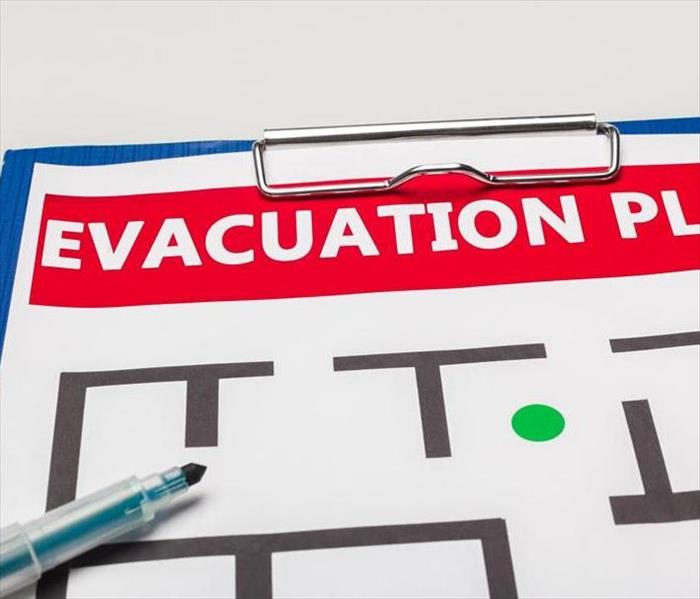 Create a family emergency plan is essential to ensure your family is safe incase of an emergency.
Create a family emergency plan is essential to ensure your family is safe incase of an emergency.
Storms can be unpredictable and have the potential to disrupt our lives and put our safety at risk. That's why it's crucial to have a well-thought-out family emergency plan in place to ensure the safety and well-being of your loved ones. In this blog post, we will discuss the steps to create a comprehensive family emergency plan that can be applied to any storm scenario.
Assess Your Risks
The first step in creating a family emergency plan is to assess the risks specific to your area. Different locations are prone to different types of storms, such as hurricanes, tornadoes, or blizzards. Research the common types of storms that affect your region and consider the potential risks, including flooding, power outages, or evacuation orders. Understanding the risks will help you tailor your emergency plan to address the specific challenges you might face.
Communication Plan
Establishing a communication plan is crucial during storms when power outages or disrupted communication networks can occur. Make sure each family member knows the emergency contacts, including phone numbers of relatives, neighbors, and out-of-state contacts who can serve as a point of contact. Consider creating a group text or using a messaging app to stay connected. Also, determine a meeting place in case you are separated and unable to communicate.
Emergency Supplies
Stocking up on emergency supplies is important before any storm strikes. Create an emergency kit that includes essential items such as non-perishable food, water, flashlights, batteries, a first aid kit, and necessary medications. Keep this kit in a designated, easily accessible area of your home. Additionally, consider having a battery-powered or hand-cranked radio to stay informed about weather updates and any official instructions.
Evacuation Plan
In some situations, evacuation may be necessary. Research the evacuation routes in your area and familiarize yourself with them beforehand. Discuss with your family where you will go if you need to evacuate, whether it's staying with relatives, in a hotel, or at a designated emergency shelter. Plan for transportation and be aware of any evacuation orders or recommendations issued by local authorities.
Home Safety Measures
Prepare your home for storms by taking appropriate safety measures. Trim trees and remove any dead branches or trees that could potentially fall and cause damage. Secure outdoor furniture or objects that could become projectiles in high winds. Consider installing storm shutters or reinforcing windows to protect against strong winds. If you live in a flood-prone area, elevate valuable belongings or consider investing in sandbags to prevent water damage.
Emergency Information and Resources
Stay informed about storm alerts, weather updates, and emergency instructions from local authorities. Sign up for emergency alerts and follow reliable sources of information such as local news channels, weather apps, or the National Weather Service. Familiarize yourself with emergency resources in your area, including shelters, evacuation routes, and disaster assistance programs.
Practice and Review
Once your family emergency plan is in place, it's important to practice and review it regularly. Conduct drills to ensure that everyone knows their roles and is familiar with the plan. Update contact information, emergency supplies, and evacuation routes as needed. Periodically review and discuss your family emergency plan to address any changes in circumstances or new information.
Creating a comprehensive family emergency plan is essential to ensure the safety and well-being of your loved ones during any storm scenario. Assessing the risks, establishing a communication plan, stocking up on emergency supplies, having an evacuation plan, implementing home safety measures, and staying informed are all crucial elements of a well-prepared emergency plan. By following these steps and regularly practicing your plan, you can better protect your family and navigate through storm situations with confidence and resilience.
Understanding the Dangers of Flood Water: Why is it Referred to as 'Black Water'?
6/15/2023 (Permalink)
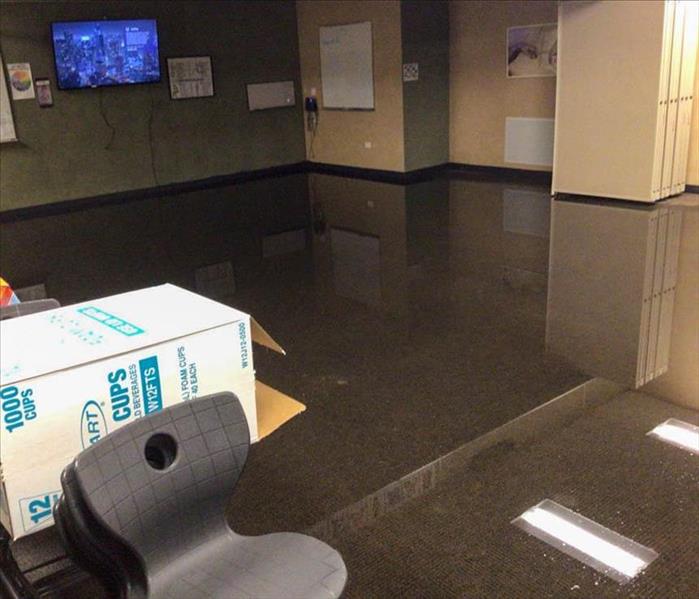 Flood water is considered "black water" because of the various contaminants it can contain.
Flood water is considered "black water" because of the various contaminants it can contain.
Black water is a term used to describe water that is contaminated with harmful substances, including bacteria, viruses, and other pathogens. It is typically associated with sewage backups, flooding from rivers and streams, and water from the ocean or other bodies of water that contain high levels of contaminants.
Why is flood water considered black water?
Flood water is considered "black water" because it often contains a variety of contaminants, including sewage, chemicals, and other hazardous materials. When flood water enters a building, it can quickly spread and contaminate anything it comes into contact with, including walls, floors, furniture, and personal belongings.
Health Risks Associated with Black Water
Exposure to black water can pose serious risks. It can also lead to the growth of mold and other harmful bacteria, which can cause long-term problems if not properly addressed.
Mitigating Black Water Damage
Due to the potential risks associated with black water, it is crucial to take immediate action if your property has been affected by flood water. It is best to seek the services of a professional restoration company that specializes in black water damage cleanup and restoration. They have the necessary equipment, knowledge, and expertise to safely and effectively mitigate the damage and restore your property to its preloss condition.
Preventing Black Water Damage
While it is impossible to completely prevent flooding and black water damage, there are steps you can take to minimize the risk. These include:
- Regularly inspecting and maintaining your property's plumbing and drainage systems.
- Ensuring that gutters and downspouts are properly installed and functioning.
- Elevating appliances and electrical systems above potential flood levels.
- Keeping valuable items and important documents in waterproof containers.
In conclusion, flood water is considered "black water" because of the various contaminants it can contain, including sewage, chemicals, and other hazardous materials. Exposure to black water can pose serious risks, and it is important to seek professional restoration services if your property has been affected by flood water. Additionally, taking preventative measures can help minimize the risk of black water damage to your property.
Top Three Signs Your Roof Has Hail Damage
12/5/2022 (Permalink)
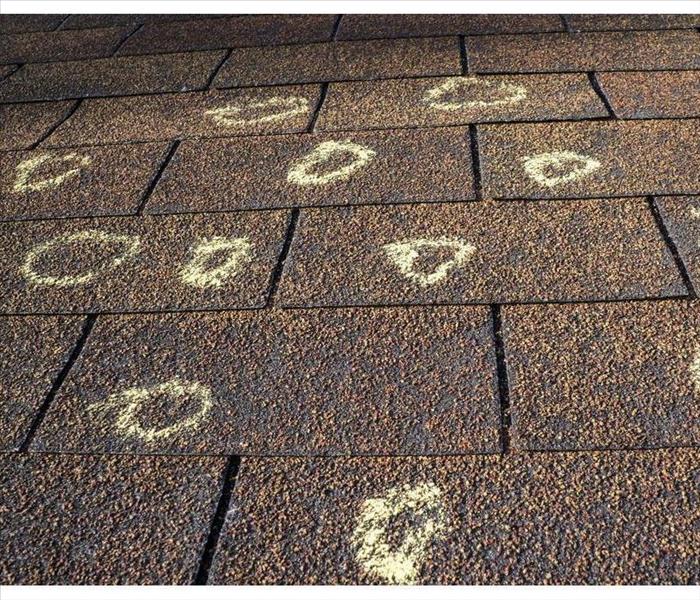 If you notice that your roof has hail damage, don't try to fix it yourself.
If you notice that your roof has hail damage, don't try to fix it yourself.
Top 3 Signs of Roof Damage
If you live in the Englewood, CO area, you are probably familiar with hail. You need to be aware of the top three signs that your roof has been damaged by hail. The first sign is obvious: if there are chunks taken out of the shingles or siding on your house. But what about those soft spots and curled or buckled shingles? Those might not be as obvious to homeowners who aren't trained in construction or maintenance. That's why it's important to know what these signs look like so you can spot them right away if they happen around your home.
What Does Roof Hail Damage Look Like?
Hail damage is difficult to spot, especially if it's on the roof. Hailstones can be up to two inches in diameter, and they are made of ice that can range from softball size to baseball size. When these stones hit your home or car, they can cause significant damage.
As a homeowner, you want to be aware of this damage so that you know when it's time for repairs. Knowing what hail damage looks like can help you identify if your roof needs repairs or not.
#1: Granules Missing from Your Shingles
As you can see, the most obvious sign that your roof has hail damage is if you notice granules missing from your shingles. If these granules are gone, it means the shingle has been hit with such force that its integrity was compromised—a serious problem that could lead to leaky roofs or even water damage in your home.
#2: A Soft Spot On Your Roof
Soft spots on the surface of your roof can be caused by either water damage or impact from hail stones. Both of these conditions can lead to leaks and more serious damage, so it's important to get any soft spots identified as soon as possible.
How do I find soft spots? The first step in identifying whether there is a problem with your home's shingles is to inspect the outside of your house thoroughly. Look for areas where the shingles may have been damaged, such as cracks in areas surrounding nails or staples that hold down the shingles or missing pieces altogether (especially near vents). You should also check along eaves and overhangs since this is where rainwater tends to collect after storms—and where it may cause problems if not addressed quickly enough!
#3: Curled or Buckled Shingles.
The third and final sign of roof hail damage is curled or buckled shingles. Hail can cause your shingles to curl or buckle, which could lead to water seepage between the shingle layers. If you suspect that your roof has been damaged by hail, call a professional for help!
If your roof has been damaged call a professional for help.
If you notice that your roof has hail damage, don't try to fix it yourself. You'll only make things worse. Instead, hire a professional roofing contractor who can assess the damage and recommend the best course of action for repairing or replacing your roof. The sooner you get help from a professional company, the better off you will be in the long run because fixing issues like this before they become too big of an issue will save money in the long run.
If you notice any of these signs on your roof, call a professional to inspect and repair it. The last thing you want is for your roof to collapse during a storm! If you do find yourself catching the roof damage a little too late, with a house full of water, give SERVPRO of Englewood/East Littleton a call!
What To Know About Floods: Sandbags and Other Prevention Measures
7/24/2022 (Permalink)
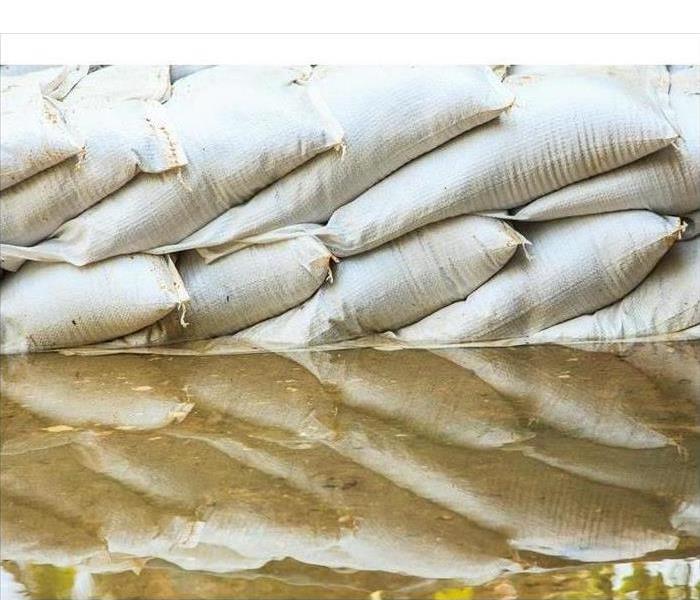 The use of a sandbag can help prevent flood water from pooling around the building
The use of a sandbag can help prevent flood water from pooling around the building
When preparing your Englewood, CO, business for a storm, you may be considering the use of a sandbag wall or other prevention measures. Yet there are a number of ways you can protect your property. Here are a few things you may want to know.
There Are Ways To Prevent Damage
There are several tools available to help building owners prevent flooding from damaging land and structures. These include:
- Sand bag walls
- Water-filled flood dams
- Permanent folding barriers
- Water-absorbing barriers
- Sloped landscaping
- Drainage installations
- Storm shutters
All of these things can help prevent water from getting into your property and causing damage.
It’s Important To Prepare Ahead of Time
When trying to prevent flood damage to your company property, it's important to prepare ahead of time. Doing so can allow you to acquire any tools or barriers you desire to use for your building. This may help prevent more costly damage in the event a storm does occur. You may find it useful to inspect and maintain any company property on a regular basis, as this also can help prevent further damage.
Cleanup Should Be Done Quickly
In the event your company property does suffer water damage it's important to begin the cleanup process as quickly as possible. Contacting a water damage restoration service, such as SERVPRO, can help speed this process along, as these professionals have the tools and knowledge needed to restore water damage before it causes additional problems.
When preparing your company property to handle a storm, it's important to prepare ahead of time. The use of a sand bag wall or flood dam can help prevent flood water from pooling around the building. If you do end up with flood damage, and it's important to take care of it as quickly as possible. If you have any questions, a professional might be able to help.
Protecting Your Home From Flooding
6/30/2022 (Permalink)
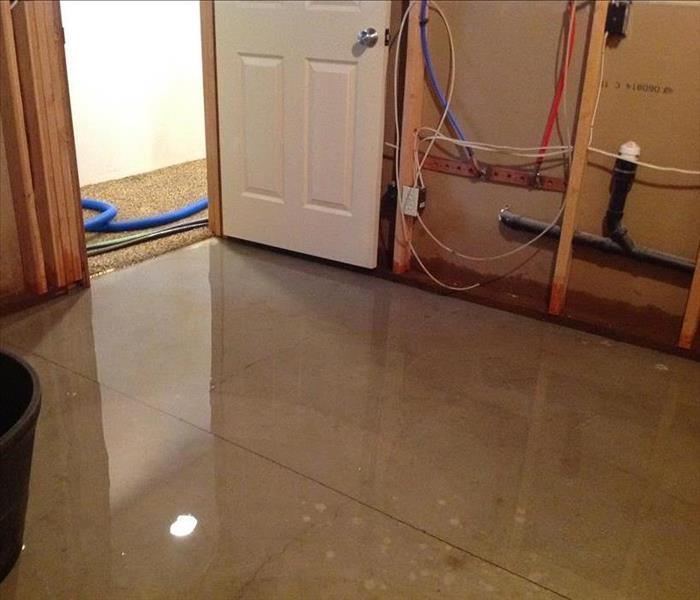 A flooded home in Park Meadows, CO.
A flooded home in Park Meadows, CO.
Flood Safety
As a homeowner in Park Meadows, CO, you want to keep your home safe from dangers and natural disasters. Flood safety is one of the things to consider to protect your family and your property. Ready.gov reports that flooding is the most common natural disaster in the United States. Here are some safety tips for incorporating into your plan.
1. Examine your home's water valves.
Flooding doesn't always mean rainwater building up in your living room—many homes flood when sewer systems back up. The best way to address this risk is to install an interior or exterior backflow valve. Gate valves, specifically, are an excellent choice, though they are more complex and operated by hand. Install valves on all pipes coming into your home for maximum flood safety protection.
2. Flood proof your electrical and heating systems.
Check all of your electrical outlets, switches, wiring, and breakers to ensure they are at least a foot over the level you expect floodwaters to reach. Similarly, your furnace and water heater should sit at the same level or higher to avoid storm damage.
3. Study how water flows around your home.
The slope of your property carries water around your home in a particular pattern. Ideally, the grading of the ground moves the water away from the house rather than toward it. To understand your flood safety risk, pick any rainy day and watch how the water flows. Take note of any areas where water may accumulate in the street and backflow onto your property. Contact the planning department in Park Meadows, CO, to request their help with this kind of stormwater runoff.
3. Tie down your outdoor equipment.
If you have outdoor equipment such as fuel tanks, HVAC units, or generators, ensure they are anchored securely higher than the expected flood level. Without sufficient anchoring, these pieces can break loose and damage your property. Also, a waterlogged generator can malfunction and fail when you need it most.
Increase Your Business's Thunderstorm Safety With These Tips
4/26/2022 (Permalink)
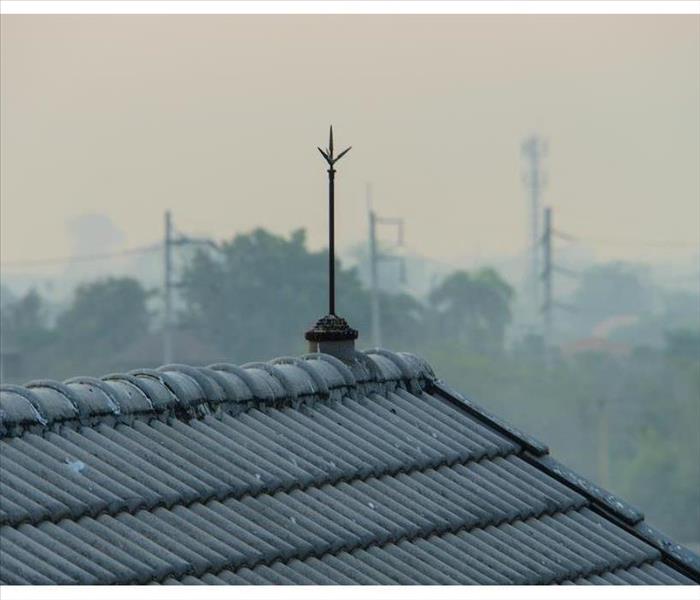 If you do not have a lightning rod, consider installing one.
If you do not have a lightning rod, consider installing one.
These Tips Will Help Your Business Stay Safe During Thunderstorms
Your business in Southglenn, CO, can be at risk during a rainstorm. Powerful winds, excessive precipitation and strong lightning can endanger the building and anyone inside. It is possible to prepare for this weather by establishing the proper measures before disaster strikes. Consider the following safety tips to protect your establishment.
1. Inform Employees of Safety Procedures
The safety of your employees is crucial during these situations, so they should know what to do when a thunderstorm arrives. Assemble a task force and create a plan that considers the responsibilities and needs of your staff.
Share this information with the employees so that they can behave appropriately during a storm. For example, they should avoid using landline phones and electronic equipment, using battery-powered alternatives instead. Ask them to meet at safe spots that are away from glass doors, windows and anything else that can shatter.
2. Install and Maintain Lightning Rods
Lightning rods are useful during a rainstorm since they ground any nearby lightning, preventing it from damaging your property. If you do not have a lightning rod, consider installing one with the guidance of the local fire department. This will ensure the system complies with all safety standards. If you already own such equipment, you can still maintain it to ensure it is in working condition when a storm occurs.
3. Control and Trim Trees Near the Facility
Trees present a major hazard to your commercial building, especially in the middle of a thunderstorm. The high winds can knock them towards other structures, damaging property and necessitating storm damage restoration. Lightning that strikes a tree can start a fire that can spread to other trees or the building itself. Avoid this issue by trimming trees enough so that they do less damage. If possible, keep trees at a reasonable distance from your building.
The impact of a rainstorm is not easy to avoid, but there are ways to mitigate it. Follow these safety procedures to reduce risks.
How To Make a Flood Insurance Claim in 3 Simple Steps
3/31/2022 (Permalink)
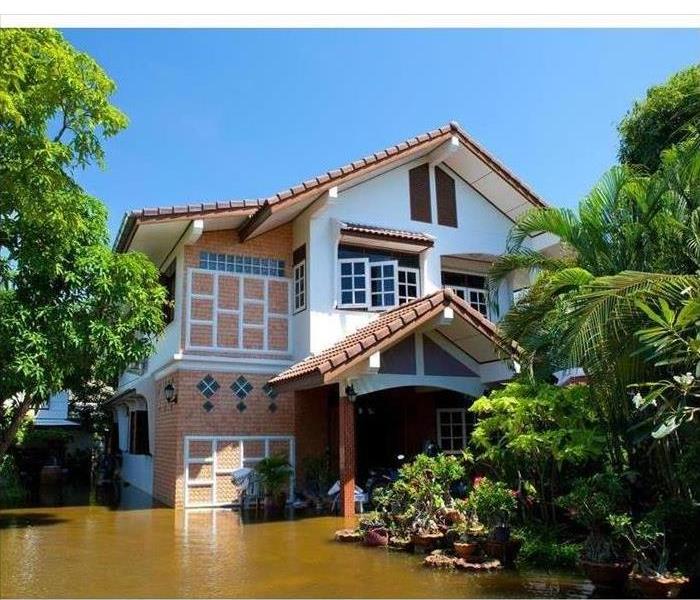 Flood damage in Greenwood Village, CO.
Flood damage in Greenwood Village, CO.
How To Make a Flood Insurance Claim
Starting cleanup efforts when a flood impacts your Greenwood Village, CO, home can be daunting. You may not know where to begin or how to go about draining away standing water. However, you can start the process by making a flood claim to your local insurance company so you can be compensated for damages as soon as possible. If you have never made such a claim before, there are a few simple steps you can take right away.
1. Take Photos of the Damage
Before you begin cleanup, take photos of all the water damage so you can send them to your insurance agent, whom you should contact right away. Remember to take this step only if it is safe to enter your home after a flood. Avoid immersing any part of your body in water that could be contaminated and use your zoom lens to take photos from a safe distance until the water can be drained away.
2. Do Not Wait for the Insurance Adjuster
Waiting for your insurance adjuster to arrive so you can make a claim may cause further damage to your home. This can be especially true if outdoor flooding has affected multiple homes on your block, as it may take the adjuster several days to reach you. In the meantime, have water drained so the drying process can begin, as this can reduce the chance of mold growth.
3. Set Aside All Damaged Items
If you call in flood damage and restoration service to help you after a flood, it is a good idea to ask them about which of your items can be restored and which you will have to list in your flood claim. Avoid throwing any belongings away until they can be examined by your flood techs, as this can make the filing process simpler when the time comes to claim the value of lost items.
Making a flood claim after your Greenwood Village, CO, home suffers water damage can be confusing. However, when you know which steps to take right away, you may have greater peace of mind when it comes to being properly compensated for your losses.
How To Limit Damage to Your Home’s Roof After a Storm
1/12/2022 (Permalink)
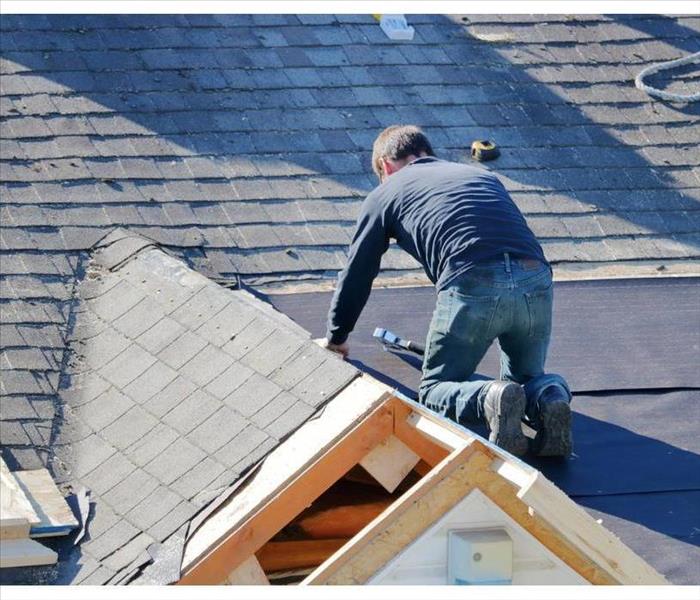 Cover damaged roofing with a tarp.
Cover damaged roofing with a tarp.
After a Storm, Here's How to Keep Your Roof From Getting Damaged
When your home’s roof is functioning properly, you may not give it much thought. If it springs a leak or sustains other damage, though, your roof can be impossible to ignore. Few things can destroy a roof faster than severe weather. If your house has survived a hurricane, tornado, thunderstorm, blizzard, or another weather event, consider taking the following steps to mitigate roof damage.
1. Use Tarps To Prevent Water Damage
The roof on your Cherry Hills Village, CO, home must be watertight. During high winds, shingles and other important components may dislodge or break. If your home has sustained wind damage, weeks may pass before you can schedule a repair. During this time, water can damage walls, insulation, carpeting and personal belongings.
Fortunately, there is a cost-effective solution. Simply cover damaged roofing with a tarp. Be sure to secure the tarp in several places to avoid both leaks and pooling water.
2. Rely on Boards To Cover Large Holes
During severe weather, entire sections of your home’s roof can sustain damage. If you have large holes in your roof, tarps are probably not sufficient to protect your house from further roof damage. Instead, you may need to use boards. The best approach is to use a 4x8 section of plywood or other lumber. You can nail these boards directly to your existing roof. You may then want to cover them with tarps for a watertight seal.
3. Find a Restoration Service Immediately
Mold and mildew can grow quickly. As you probably know, these fungi can destroy the comfort, appearance and value of your house. Unfortunately, the longer you wait to contact an emergency restoration service, the worse damage may become. As such, ask a reputable specialist to perform an assessment as soon as you can.
Roof damage can lead to significant problems inside and outside of your home. Instead of leaving your home’s condition to chance, work to mitigate damage after severe weather.


 24/7 Emergency Service
24/7 Emergency Service






